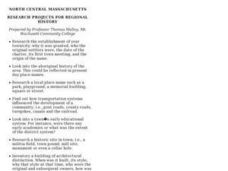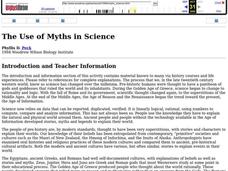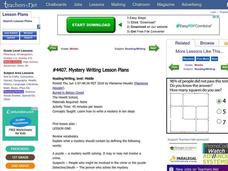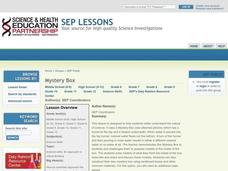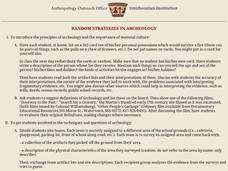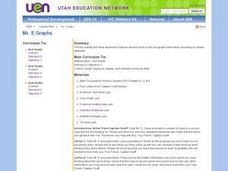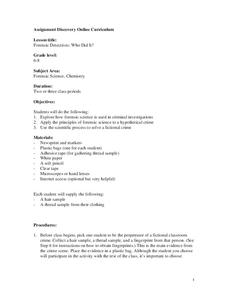Curated OER
Build Mastery: Purpose for Reading
Do you agree? Set up three stations in your room for this reading comprehension activity: I agree, I disagree, and I'm not sure. Learners listen to statements and walk to the sign that best describes their response. Model...
Curated OER
Revolutionary War Era Research Project
Young historians interpret historical evidence presented in primary and secondary resources in this American Revolution lesson. They select topics from the time era that they are interested in researching. Additionally, they follow...
Curated OER
Research Projects for Regional History
Young writers of any grade level research a historical topic of their choice about their local community. Using primary sources, they examine the historical significance of their area. They participate in activities such as going on a...
Curated OER
Developing Models
Young scholars study the concept of a scientific model and demonstrate climate change models. For this scientific lesson students design a model using direct and indirect evidence and use it to make hypotheses.
Curated OER
Predicting a Mystery's Solution
Awarded the 1998 Edgar Award for Best Children's Mystery, Sammy Keyes and the Hotel Thief offers readers a chance to hone their predictive and deductive skills along with Sammy Keyes, who the Midwest Children's Book Review calls "the...
Curated OER
Forensics Crime Lab
Students brainstorm ways to look for evidence and investigate suspects. For this investigative lesson students pretend to be investigators and analyze a crime scene.
Curated OER
Who Did It?
Students explore how forensic science is used in criminal investigations. They learn that for the next few days that are going to try to solve a crime that took place in the classroom. Students are given a story to read about the crime...
Curated OER
The Use of Myths in Science
Students examine folk tales to determine the basis for scientific myths. They demonstrate through the discussion of the folk tales that the perception of the world has changed as new information is gained. They write their own folk...
Curated OER
Conducting a Scientific Investigation
Students investigate a possible health problem in the local school district through inquiry into attendance records, activities, maps, graphs, and data tables. The simulation continues as solutions for the problem are sought.
Curated OER
Mystery Writing Lesson Plans
Introduce your class to the genre of mystery. Included is a vocabulary list, a rubric, and a sample mystery story called "Lethal Lesson." There are very limited directions on what to do with these resources, so you will need to plan some...
Curated OER
Using Evidence to support Arguments
A directive on how to use evidence to support an argument, the text-heavy slides in this presentation define salient terms but offer few specific examples to illustrate concepts.
Curated OER
SATs, Shakespeare Paper
By using PEE (Point, Evidence, Explanation) exam takers will be taken through a study guide on Shakespeare test questions. Character motivation, analysis of text, ideas, themes, and issues will all be covered in this "how to" answer SAT...
Curated OER
Results and Conclusions
Fourth graders practice using the scientific method. In this results and conclusions lesson plan, 4th graders review data collected, create a graph of their data and make their final conclusions about the information collected.
Curated OER
Conducting Research
Third graders conduct research. In this conducting research lesson, 3rd graders discuss the importance of nonfiction text in providing factual information. Students write questions about an assigned topic and research using informational...
Curated OER
The Fossil Evidence for Evolution
Students explore how scientists use fossils to explore how various species have evolved over time. In this fossil lesson students study how to date fossils.
Curated OER
Mystery Box
Students explore why scientists use models to help them explain things that cannot be seen. For this predictions lesson students make a prediction based on observations and collected evidence.
Curated OER
Much Ado About Nothing: Masks
in this character worksheet, students fill out a sheet about the characters in the book Much Ado About Nothing and write their character traits and evidence of this trait. Students do this for 6 characters.
Curated OER
Listening to Gather Evidence in a Reading Selection
Fourth graders explore an Ethiopian folktale, "Fire on the Mountain." In this literature lesson, 4th graders evaluate and record the evidence, as well as make predictions about what they think will happen. Students evaluate other groups...
Curated OER
Discovering Dinosaurs
Students discuss that scientists have theories about what dinosaurs were like but are unsure because they are no longer living. In this dinosaur research activity, students examine how scientists use evidence to determine the behavior...
Curated OER
Random Strategies in Archaeology
Young scholars critically evaluate cultures according to their artifacts. In this Random Strategies in Archaeology activity, Students interpret evidence in order to better understand ancient societies. Young scholars watch films that...
Curated OER
Scientific Method
In this scientific method worksheet, students read and discuss a 2 page article on the scientific method, match 3 founders of the scientific method with what they found or produced, answer 4 statements as true or false, list 3 crucial...
Curated OER
Math: Mr. E Graphs
Second graders role-play as members of the "Math Graph Detective Academy" and assist in solving a mysteries. Once they have watched a "top secret" video, they sort objects according to traits into five categories. Throughout five...
Curated OER
Life Science: DNA Whodunit?
Students role play an honorary detective to assist in solving a crime committed. They investigate by a bank robbery and interview eyewitnesses using their Crime Investigation Notebook and clues from an eyewitness account from the...
Curated OER
Forensic Detectives: Who Did It?
Students explore forensic science and its uses in criminal investigations. They solve a fictional crime by identifying and analyzing the fingerprints, strand of hair, and thread samples for evidence. After completing charts for each,...




